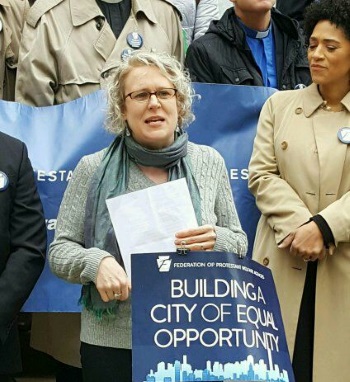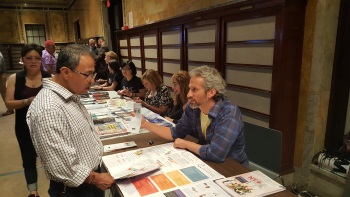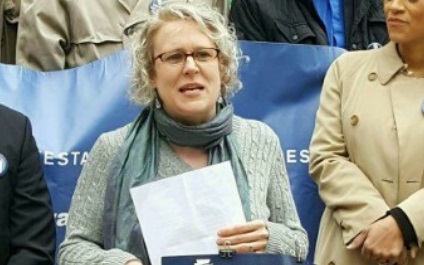This is a post in our blog series highlighting the different programs at the New York Immigration Coalition. Check back every week to learn more about the programs that help advocate for New York’s immigrant communities!
The Health Advocacy Program at the NYIC advocates for health care policies that will include everyone, specifically those from the immigrant community. It also seeks to inform immigrants about their health rights and provides spaces for them to talk about their needs and discuss ways that they can be helped.
I spoke with Claudia Calhoon, Director of Health Advocacy, and Max Hadler, Health Advocacy Specialist, to talk more about their program area.

Claudia Calhoon at City Hall for the Federation of Protestant Welfare Association Advocacy Day on May 5, 2016
What is the Health Advocacy Program all about?
Claudia: The Health Advocacy Program works to make the health care system work better for immigrant communities. For example, the NYIC and other organizations advocated for increased funding from the New York City Council to support outreach and education around topics such as health rights, access to health care, and what one can expect in terms of language protection.
Max: Another crucial initiative is the Coverage 4 All campaign. This is a statewide campaign to extend coverage options to all, regardless of their immigration status or any other factors that prevent someone from getting insured. The NYIC and Make the Road lead a coalition of organizations working on on human rights and workers rights issues, as well as faith-based and health groups, to act as advocates for the campaign. The purpose is to push the state to provide more funding to support healthcare for all immigrants.
How does the program engage the immigrant community?
Claudia: We have a health collaborative which brings organizations together once a month to talk about what is happening in health care, and about what kind of support these groups need to keep fighting for health care reform. We also participate in the NYIC’s Key to the City events and in town halls. At these events, we get to talk to people, learn more about their needs, and provide information to immigrants or the people who represent them.
Sometimes, we go into immigrant communities and talk about health rights and what community members should be able to demand. New York has a lot of protections when it comes to health care, but it is only helpful when people know about them and demand them; therefore, we try to make people aware of this information so that they can advocate for themselves.
We also do trainings for organizations within and outside New York City, focusing on immigrants’ eligibility for health coverage programs, access points that don’t depend on health coverage, and immigrants’ right to receive linguistic and financial assistance related to their health care.
Max: Some of our contact is not directly with the immigrant community, but we work with our members and other organizations in the community and provide the funds and trainings they need to support the people in their communities well. Now that we have a new informational foldout poster, which we developed together with the Center for Urban Pedagogy, we can distribute information directly to our members and people within immigrant communities.
Why is health advocacy important?
Claudia: The lives of immigrants and their families become much harder without health or access to healthcare. For example, if people don’t have access to healthy food or to health insurance, then they can’t go to school or work and they will be less likely to vote because they are restricted by their illness. If you are not insured, health care becomes a significant financial burden - people go into debt because they are unable to get insurance for whatever reason. So health advocacy is a way to help immigrants and their families thrive, so that they can contribute to their community and the country’s economy.
Max: There is phenomenon in which people within immigrant communities are healthier than nonimmigrants, but this health advantage decreases over time because of the negative health behaviors immigrants adopt because they do not have access to health care. Furthermore, health is not just physical - it is also about mental wellbeing. Just the stress of thinking about health care, or how to get access to it, or not feeling comfortable going to a healthcare provider can be harmful to a person’s mental wellbeing - which can in turn affect their physical wellbeing. We try to ensure that immigrants and their families don’t have to worry about these issues by advocating for them.

Max Hadler at an Administrative Relief Town Hall on Thursday, June 30, 2016 showing someone the NYIC’s Welcome to Healthcare foldout brochure on health care rights and protections in New York State
What have been some challenges that the program has had?
Claudia: When I started in 2014, we did not have the resources we do now. For instance, for a long time, I did a lot by myself, but now I have another person on my team and we can bounce ideas off each other. We need the human and financial capacity to ensure that when we are writing grants or thinking about new programs we are doing it the best way we can. Also, we are always thinking about which grants to apply for and which agencies and funding we can get, and how best to represent their mission as well as ours.
Max: We have had success in the first year of our Coverage 4 All campaign in terms of generating support on the city level, but the challenge now is trying to generate that interest on that State level - to push the state government to support the campaign. We really don’t know how the Governor will respond to this campaign. There is also a challenge in trying to explain the importance of immigrants getting health coverage in a way that will bring in support from different people.
What have been some of the successes the program has had?
Claudia: One of the big things was the City Council funding that we received. It was exciting because we were able to tell the Council why our work is important.There was funding from the state for health care navigators - people who help others enroll for health care - but there wasn’t a lot of funding for people to go into different communities to explain their options in a way they can understand, so we really pushed the city to fill the gap left by the state. Another big success was the Center for Urban Pedagogy foldout poster we created on health care. That is something we had been working on for a very long time, and now we have a way to distribute information much more easily and people have responded really well to it.
Max: The National Immigration Law Center has a national campaign around expanding healthcare access, and providing information about health care access, and the NYIC has been a partner in this campaign. Through this, we’ve been able share and learn many different ways of providing information about health care.
What are some projects that this program has led?
Max: We participated in the NYIC’s regional convenings this summer to talk about the Coverage 4 All campaign and also trying to expand the campaign statewide. We had a convening at Syracuse on July 27 and another in Rochester on July 28th.
Any final thoughts?
We have made a lot of progress expanding access to healthcare for immigrants in New York, but our work is far from done. Immigrants still face unjust barriers to care that must be reversed to ensure equality of opportunity and the preservation of health. The NYIC is proud to be a leading member of this fight.

